

The terrorist attacks of September 11, 2001, brought to the forefront the problem of terrorism and has raised the question of how terrorists should be treated and punished for their crimes. This paper reports the results of a survey of college students at two Midwestern universities concerning terrorism and terrorists and examines whether criminal justice majors differ from other majors in their views on terrorism and the punishment of terrorists. While criminal justice students may differ on their attitudes on a variety of social issues, terrorism is not one of them. The results suggests that for the most part, criminal justice majors and students majoring in other disciplines share common attitudes toward the handling and punishment of terrorists, particularly those linked with the September 11, 2001, attacks. It appears that as the seriousness of the offense increases, so to does the level of punitiveness.
* This paper is part of presentation made at the 2002 American Society of Criminology in Chicago. The authors thank Janet Lambert for proofreading and editing the paper. Finally, the authors thank the anonymous reviewers for their comments and suggestions.
The U. S. is at war with an elusive enemy. The enemy is terrorism, and the war was formally initiated by President George W. Bush shortly after the terrorists attacks of September 11, 2001. It is one of the most unique wars in U.S. history. Unlike most enemies of the past, however, the enemy of terrorism is difficult to define, is difficult to find, and the objectives of the war are many times unclear. It will probably take years, if not decades, to remove the threat of future violence and harm to U.S. citizens posed by terrorists. In short, terrorism is an elusive enemy. While it is a war, many of the efforts being waged are taking place within the criminal justice system, such criminal prosecution of John Walker Lindh (the American Taliban), the trail of the Zacarias Moussaoui (the 20 th hijacker), the arrest and prosecution of Richard Reed (the shoe bomber), and the arrest and detention of Jose Padilla (U.S. citizen accused of trying to build a dirty nuclear bomb). There are numerous more but less famous cases, in which the U.S. criminal justice system is being called upon to help in the was against terrorism. Consequentially, federal, state, and local law enforcement officers have increasing responsibility to investigate, arrest and interrogate and incarcerate suspected terrorists. Federal and state courts have in the past and may again in the future be called upon to adjudicate accused terrorists (Smith, Damphousse, Jackson, amp; Sellers, 2002).
In the 2000 Presidential election, crime was a less significant issue than it had been in recent presidential elections. Rather, the economy, prescription drugs, and education were of concern. The aftermath resulting from the terrorists attacks of September 11, 2001, led to the demand for greater resources to combat terrorism, including for the criminal justice system. This has included additional resources for select areas of the criminal justice system, such as the demand for more criminal justice personnel. This means that many students currently majoring in the field of criminal justice will have additional and greater employment opportunities than did graduates before September 11, 2001. While the war on terrorism is a new area that many criminal justice college programs across the program will have to address in their curricula, if they have not already done so, it is unclear of how criminal justice students view terrorism and how to respond to terrorists. Today, over 350,000 students are majoring in the field of criminal justice in over 1,000 colleges and universities across the nation (Schmalleger, 1999). Most criminal justice majors find the subject interesting, relevant, and think that it will increase their job opportunities (Krimmel amp; Tartaro, 1999). Farnworth, Longmire, amp; West (1998) point out that many criminal justice students #8220;aspire to positions as practitioners and administrators with an opportunity to influence or implement crime control policies#8221; ( p. 39). As practitioners and administrators, many criminal justice graduates may be called upon to educate the general public on the best ways to respond to terrorism. Therefore, the attitudes of criminal justice majors and whether they differ from other students have important sociological and political implications. In addition, many professors who teach in the field of criminal justice are interested in how their students are similar or different from students in other fields. Consequently, an exploratory study was undertaken using students from two public Midwestern universities to see what, if any, differences exist between criminal justice and non-criminal justice majors in terms of their attitudes on terrorism related issues.
There is a small but growing body of literature that has explored the differences in attitudes and views between criminal justice students and students majoring in other disciplines (Farnworth et al., 1998). There is no consensus from this limited literature. Several studies present criminal justice majors in a positive light when compared to non-criminal justice students. Tsoudis (2000) found that criminal justice majors at a large urban Midwestern university were less supportive of harsh sentences, more supportive of a criminal defendant#8217;s rights, and more supportive of treating juvenile offenders differently than adult offenders than were non-criminal justice students. Tsoudis (2000, p. 233) contended that #8220;majoring in criminal justice influences perceptions about punishment, crime and the criminal justice system.#8221; McCarthy and McCarthy (1981) concluded that criminal justice students were more likely to support due process principles as well as rehabilitative treatment of offenders. Fabianic (1979) found criminal justice majors had higher libertarianism scores than did non-criminal justice majors. Criminal justice majors were also found to be less fearful of crime and victimization for both personal and property crime categories (del Carmen, Polk, Segal, amp; Bing, 2000). Sandys (1995) found that a special topic class on the death penalty had a significant impact on support for capital punishment among the 23 students in the course. Opposition for the death penalty increased from 30% to 65% by the end of the class. Based upon the aforementioned literature, it would appear that majoring in criminal justice may have a liberating effect, where criminal justice students are more supportive of rehabilitation and individual rights than are students in other disciplines.
On the other hand, other studies suggest that criminal justice majors are more conservative, more likely to support punitive sanctions, and more likely to feel that it is acceptable to protect society from crime at the expense of individual rights. Mackey and Courtright (2000) argued, #8220;From our experiences teaching a variety of courses in criminal justice, our observations led us to believe that criminal justice majors possess more punitive attitudes toward offenders than do students in other majors, and that the former also differ in their beliefs regarding what constitutes fair and equitable punishment for the transgressions of offenders#8221; (p. 424). Their views were confirmed in their survey research of students at five Northeastern public and private universities. Criminal justice majors were observed to be significantly more punitive in their views of punishment of criminal offenders than were non-criminal justice majors. Criminal justice majors have also been found to have higher levels of authoritarianism (Austin amp; O#8217;Neill, 1985) and were more dogmatic than students not majoring in criminal justice (Merlo, 1980). Additionally, Austin and Hummer (1994) observed that male criminal justice students hold unfavorable views about females police officers. In a study of students at four Texas universities, Farnworth et al. (1998) found that when looking at all majors, there was less support for capital punishment among seniors as compared with freshman. They, however, found a smaller attitudinal change between freshman and senior criminal justice majors, suggesting that criminal justice majors were more supportive of capital punishment, even after four years of undergraduate education. This suggests that studying criminal justice may reinforce student support for the death penalty than is the case among students studying other disciplines. Additionally, Farnworth et al. found on other measures that criminal justice seniors held more punitive views than did criminal justice freshmen. Olivero and Murataya (2001) found that students in the law enforcement and corrections tracks at Central Washington University had higher levels of homophobia than did students majoring in other areas. This body of literature suggests that criminal justice majors are more conservative, punitive, and less supportive of individual rights than are students majoring in other disciples.
Still other studies have found no attitudinal differences between criminal justice and non-criminal justice majors. In a study of students at a small, private Northeastern Jesuit university, it was observed that criminal justice and non-criminal justice majors were not statistically different in how they defined justice or in their goals for criminal justice agencies and personnel (Wolfer amp; Friedrichs, 2001). Byers and Potters (1997) found that there was no difference in the ethical orientations of criminal justice and non-criminal justice students at a Midwestern public university. Similarly, criminal justice students were found to be no different in their level of cheating than students in other majors (Eskridge amp; Ames, 1993; Tibbetts, 1998). Furthermore, Giacopassi and Blankenship (1991) found that an introductory course in criminal justice did not effect students#8217; attitudes towards the police.
In summary, the findings if and how criminal justice students are different in their attitudes and behaviors from other college students are mixed and often contradictory. Moreover, no published study that examined the attitudes of criminal justice majors on terrorism, the punishment of terrorists, or related issues as compared to non-criminal justice majors could be located. Therefore, the attitudes of criminal justice majors, including what methods they believe should be used to address the problem and how terrorists should be punished, are unknown.
The purpose of this exploratory study was to determine whether criminal justice majors differ from other students in their attitudes towards the handling and punishment of terrorists. Criminal justice students are likely to have a greater impact on our future response to terrorism than students majoring in other fields. The attitudes expressed by today#8217;s criminal justice students provide insight to what may be our future policies and practices in handling terrorists.
No published study could be found that has examined the attitudes on terrorism for criminal justice majors. The literature on criminal justice majors is often inconclusive and contradictory. On some social issues other than terrorism, some of the literature indicates that criminal justice majors tend to be more punitive, less supportive of individual rights, and more conservative than students majoring in other disciplines. Conversely, other literature suggests that criminal justice majors are more open-minded and are more supportive of rehabilitation and individual rights. Still other studies have found no relationship. Therefore, no hypotheses were made concerning if there would be difference between criminal justice and non-criminal justice majors on their attitudes towards terrorism.
The data for this study came from a survey of undergraduate college students at two public four-year universities in the Midwest1 . The first university is a nationally ranked doctoral state institution with an enrollment of about 20,000. The second university is a regionally ranked state institution with an enrollment of approximately 5,000. A non-random, convenience sampling design was used to select the students in the study. A convenience sample is a method where the researcher selects individuals who are available and willing to be part of the study (Hagan, 1997). Over 25 college courses offered during the 2002 Winter semester were selected for administration of the survey. On average, there were 20 to 40 students in each of the selected classes. The classes represented a wide array disciplines, including general education classes required by all majors at the university. Criminal justice classes were also selected so that a comparison of the views of criminal justice and non-criminal justice majors on the subject of terrorism and punishment of terrorists could be made.
A survey was provided to students who attended class on the day of the survey administration. Students were asked to participate in the study by voluntarily completing the survey during class time. This was done to improve the response rate, since students would have the time to complete the survey and could easily return it. The students were informed that the survey was voluntary. More than 95% of the students present took the survey. A total of 565 usable surveys were selected for use in this study. Two hundred and sixteen (38%) of the surveys were from students at the regional university and 349 (62%) were from students at the nationally ranked university.
There was variation in the demographic characteristics of the respondents. About 53% of the student respondents were female and 47% were male. Age was measured in years. The median age was 20 and ranged from 18 to 68 years of age. The mean age was 21.38, with a standard deviation of 4.34. Approximately 77% of the respondents were White, 13% were Black, 7% were Hispanic, and 3% were from another race/ethnic group. In terms of college level, 25% were freshmen, 22% were sophomores, 26% were juniors, and 27% were seniors. In terms of majors, 49% of the respondents were criminal justice majors and 51% were majoring in other disciplines.
Among the criminal justice students, about 51% were men and 49% were women. Fourteen percent of the indicated that they were Black, 6% were Hispanic, 98% were White, and 2% were another race. The median age was 21, and the mean age was 21.30, with a standard deviation of 3.27. Almost a quarter of the criminal justice respondents were freshmen, 18% were sophomores, 31% were juniors, and 27% were seniors. Finally, 42% of the students majoring in criminal justice were from the regional Midwestern university and 58% were from the national Midwestern university. Among the students majoring in other disciplines than criminal justice, 58% were females and 42% were males. About 12% were Black, 8% were Hispanic, 75% were White, and 4% were another race. The median age was 20, and the mean age was 21.46, with a standard deviation of 5.18. About 26% were freshman, 26% were sophomores, 20% were juniors, and 28% were seniors. Finally, 35% of the non-criminal justice majors were from the regional university and 65% were from the national university. Based upon the independent t-test, there was only a significant difference between the two groups for gender2 . More males tended to major in criminal justice, while more females majored in other areas. This was expected since some majors tend to attract more male than female students, such as criminal justice, and other majors tend to attract more females than males, such as nursing. Therefore, the criminal justice and non-criminal justice majors are similar to one another in terms of demographic characteristics, except for gender.
A total of 26 questions dealing with terrorism, the punishment of terrorists and related issues were selected from the survey. Twenty of the questions were measured using a five-point Likert type of response scale ranging from strongly disagree to strongly agree. The specific questions are presented in Table 1. Another 6 questions were asked that used different response options. These questions are presented in Tables 3 through 8.
The percentages for the frequency results of the entire sample, of criminal justice majors, and of non-criminal justice majors for the 20 questions measured using the five-point Likert type of response scale are presented in Table 1. The majority of the students agree that terrorism is one of the most serious problems facing the United States. The majority of students indicated that they either fear or are uncertain about future terrorist attacks. Many students recognized that terrorism is a difficult term to clearly and concisely define. Only a third of the students felt that race and ethnic status was necessary to identify potential terrorists. The majority of the students indicated that there should be a reduction of rights for those suspected of terrorism. Only about a third of the respondents were supportive of the use of secret military tribunals for those accused of terrorism, regardless of U.S. citizenship. Most students were uncertain about the use secret military tribunals. Many students were supportive of the freedom of speech. Only 18% either agreed or strongly agreed that those who speak out against governmental policies on the war on terrorism are supporting terrorism. About an equal number opposed as supported allowing the government to listen to private conversations without a court order. While many students felt that torturing terrorists was acceptable, it was not a majority view. The respondents were divided between supporting, opposing, and being uncertain if torturing of suspected terrorists was acceptable. It appears that there were differences between the respondents in how to best respond to fighting the war on terrorism. There is less disagreement on the punishments for terrorists.
The vast majority of students indicated that terrorists must be punished for their crimes. Almost three-fourths indicated that terrorists who kill deserve the death penalty, and the majority (60%) of students indicated that they would be angry if the individuals linked to the September 11, 2001, attacks were not sentenced to death. Moreover, 52% of the respondents either strongly agreed or agreed with the statement that terrorists connected with the September 11, 2001, attacks should not be allowed to appeal their sentences, even if they are sentenced to death. While the majority (60%) of students felt that most terrorists would kill again if not killed or executed, most (61%) indicated that capital punishment would not deter future terrorist attacks. Finally, the students as a whole were divided on whether the United States government should assassinate suspected terrorists found in other countries.
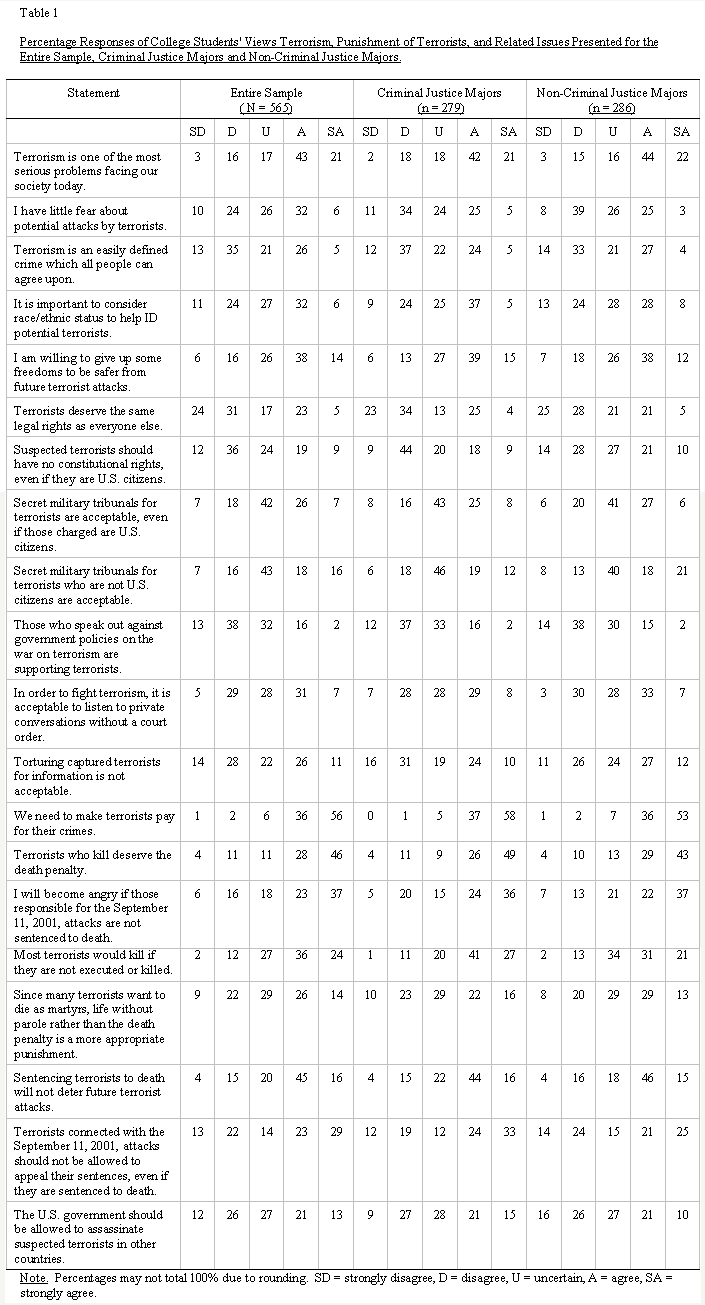
While the attitudes of the students are interesting in the themselves, the purpose of this study was to examine whether there are significant differences between criminal justice majors and students majoring in other disciplines. Looking at the percentages presented in Table 1, there appears to be only minimal differences between criminal justice and non-criminal justice majors in their views and attitudes toward terrorism, the punishment of terrorists, and related issues. In order to statistically test this observation, the independent t-test was used. The results are reported in Table 2. There was a statistically significant difference between criminal justice majors and students majoring in other disciplines on 5 of the 20 measures. Criminal justice majors were more likely to feel that society must make terrorists pay for their crimes. Criminal justice students were more likely to agree with the statement that most terrorists would kill if they were not executed or killed. Students majoring in criminal justice were more likely to agree with the statement that terrorists connected with the September 11, 2001, attacks should not be allowed to appeal their sentences, even if they are sentenced to death. Criminal justice students were more likely to agree that the U.S. government should be allowed to assassinate suspected terrorists in other countries. Finally, non-criminal justice majors were more likely to feel that torturing captured terrorists for information was unacceptable.
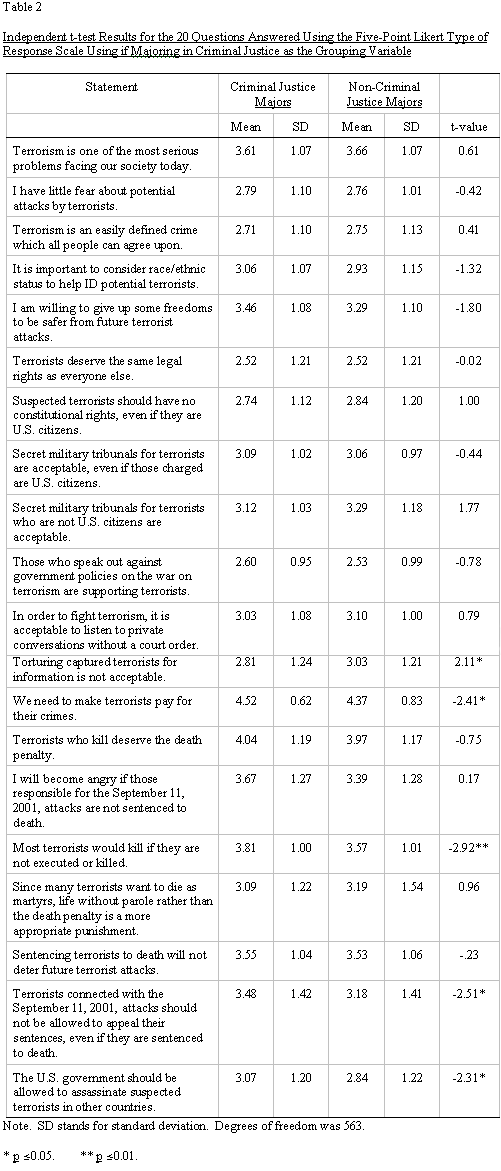
As indicated in the methods section, six additional questions were asked which used different responses categories. Students were asked in what setting suspected terrorists should be tried (see Table 3). No single setting was marked by the majority of the students. Slightly less than a third of the students felt that suspected terrorists should be tried in an open U.S. criminal court. Open military tribunals and closed military tribunals were each selected by 17% of the respondents. About 19% indicated that an international court was the appropriate venue, while only 4% indicated the court in the country in which the person was arrested. While criminal justice students were less supportive of trying suspected terrorists in U.S. criminal courts and were more supportive of using military tribunals, based upon the Chi-Square test, this difference was not statistically significant. Both groups of students are divided in whether U.S. criminal courts, U.S. military tribunals, or an international court are the appropriate setting to try persons accused of terrorism.
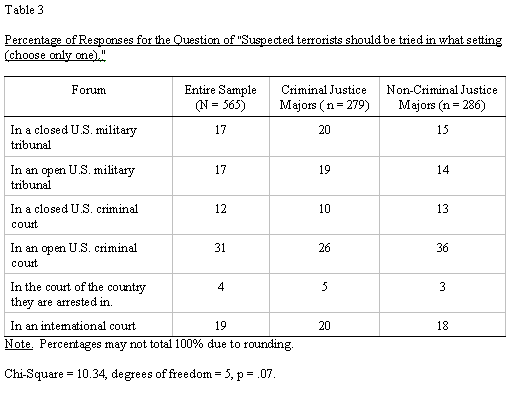
When asked how the U.S. should proceed in cases where foreign governments refuse to extradite a person who might face the death penalty, slightly over half of the respondents felt that the U.S. should agree not to seek the death penalty and honor that agreement. Only 21% indicated that the U.S. should use non-violent sanctions, such as economic, to force the extradition of the suspected terrorists. Less than 10% indicated that the U.S. government should lie about not seeking the death penalty and impose the death penalty nevertheless, use military force to compel extradition, to kidnap the suspect, or to assassinate the person. The specific responses to this question are presented in Table 4. Based upon the Chi-Square test, there was no significant difference between criminal justice and non-criminal justice students in their responses for this question.
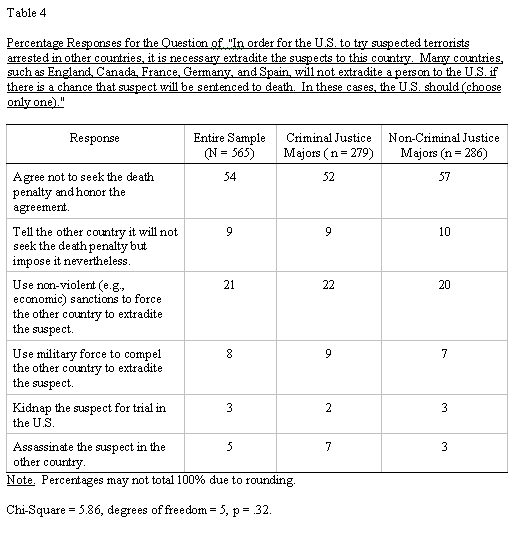
Most (55%) students felt that it was either very unfair or unfair that terrorists extradited to this country might not face the death penalty when those arrested on U.S. soil could be sentenced to death for the same actions (see Table 5). Only 17% of the students indicated that it was fair or very fair. There appears to be little difference in the percentage responses between the two groups of college students. Both the Chi-Square test and the Independent t-test indicated that there was no significant difference between criminal justice students and students majoring in other areas on their responses for this question.
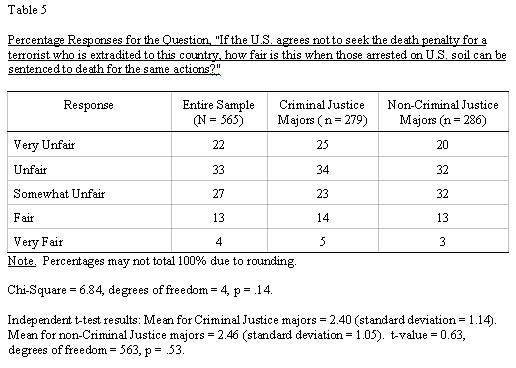
Students were asked how important is it that the U.S. have other nations as allies in the war on terrorism. The results are presented in Table 6. The majority (60%) of the students felt that is was very important. Less than 10% indicated that is was somewhat important or not important to have allies on the war on terrorism. Based upon both the Chi-Square test and the Independent t-test, there was significant differences between the two groups. Criminal justice majors were more likely to feel that it is important or very important to have other nations as allies in the war on terrorism than were non-criminal justice majors.
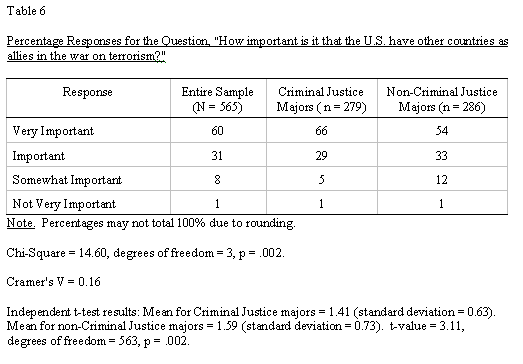
Students were also asked about the impact capital punishment would have on the war on terrorism since many countries adamantly oppose the death penalty. The results are presented in Table 7. Very few of the students felt that the death penalty would have little impact. Most students (66%) felt that the death penalty would be either important or somewhat important in the war on terrorism. Based upon the Chi-Square test, there was a small but significant difference between criminal justice and non-criminal justice students in their responses, with criminal justice majors slightly lower in their view that capital punishment will have an important impact in the war on terrorism. Conversely, the independent t-test indicated that the difference is insignificant. Since the two tests of significance are split, it was decided to view the difference between the two student groups as insignificant.
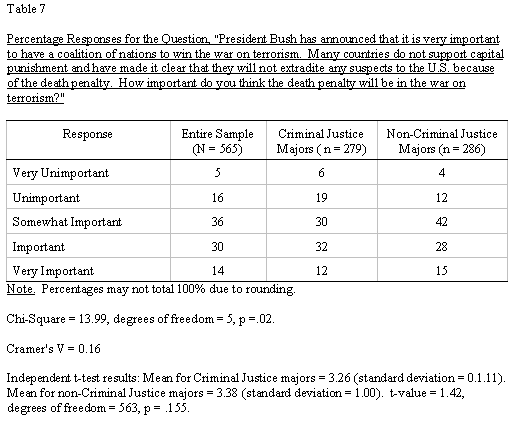
A final question about the deterrent effect of the death penalty for terrorists was asked and the results are presented in Table 8. About 45% of the respondents marked that the death penalty would have no or very little deterrent effect, and 37% indicated that it would have only a small deterrent effect. Almost no student felt that sentencing convicted terrorists to death would have either some or significant deterrence on future terrorist acts. There was no statistically significant difference between criminal justice and non-criminal justice majors on this question.
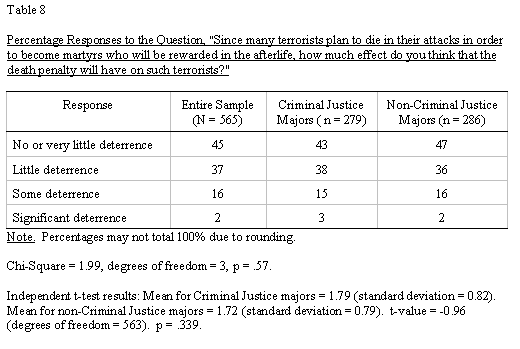
There appears to be few differences between criminal justice and non-criminal justice majors in their views and attitudes toward terrorism, the punishment of terrorists, and related issues. On 6 of the 26 measures there was a statistically significant difference between the two groups of students. One finding is that criminal justice students appear to fall more toward the crime control end of Herbert Packer#8217;s due process/crime control model than do students of other majors (Packer, 1968). That is, criminal justice students in this study appeared to be more supportive of fighting crime than protecting due process. This would explain why criminal justice majors were less opposed to torturing captured suspects for information than were non-criminal justice majors. Criminal justice students may feel that the information gained from torturing suspected terrorists outweighs an individual#8217;s right not to be tortured. There is an old debate if it is better to let 99 guilty people go free than to send 1 innocent person to prison or to send 1 innocent person to prison rather than let 99 guilty persons go free. It appears that for many of the criminal justice majors in this study, the needs of the many outweigh the rights of the few.
The finding that criminal justice students being more likely to believe that terrorists would kill again if they are not executed or killed can be explained by the fact that criminal justice majors are more likely to be exposed to information that many criminals released from state custody recidivate. It appears that they expect the same for terrorists. The two most surprising findings were that criminal justice majors were willing to forgo the appeals process for convicted terrorists and their support for governmental assassination of suspected terrorists. Again, this is supportive of the position that criminal justice majors are more concerned with the control and suppression of crime than the due process of those charged with terrorist crimes. Finally, the reason that criminal justice students were more likely to feel that having allies in the war on terrorism was very important is that criminal justice students are probably more aware of the importance of task forces in dealing with crime, particularly in the war on drugs. When there was a difference, criminal justice students tended to be conservative in their views and more oriented towards crime control than the protection of rights and liberties. This finding is supported by the findings of Mackey and Courtright (2000) who found in their study that criminal justice majors were more punitive than non-criminal justice majors.
What is more interesting is that on 20 of the measures, there were no statistically significant differences between criminal justice students and students in other majors. This could be the result of the terrorist attacks of September 11, 2001, and the resulting media coverage. For several days, the only coverage on the television for U.S. citizens was of the devastating and horrific terrorist attacks. The loss of life was staggering and probably unheard in the lifetimes of most of the students. It is well known that the media can influence people#8217;s attitudes and decisions (Heath amp; Gilbert, 1996; Perse, Ferguson, amp; McLeod, 1994), particularly for crime-related issues (Garofalo, 1991). There is a barrage of material presented on crime outside the classroom, such as television, newspapers, magazines, movies, etc. (Lotz, 1991; Marsh, 1991; Vandiver amp; Giacopassi, 1997). Much of this is inaccurate, exaggerated, and aimed more for sensationalism than for the purpose of knowledge (Selke, 1980). The mass media tends to present inaccurate information concerning crime, punishment, and the U.S. criminal justice system (Lotz, 1991; Marsh, 1991). Mass media overemphasis of violent crime has lead to a demand by the public for harsher punishments (Surette, 1990). Since the media provided in-depth coverage and created a climate of fear, it is not surprising that the majority of the students in this study, regardless of their major, were willing to give up some constitutional rights, wanted reduced due process for those accused of terrorist crimes, and demanded the death penalty for those linked to the terrorist attacks of September 11, 2001. Vandiver and Giacopassi (1997) write, #8220;Even good students may begin their study of criminal justice with many misperceptions about crime fostered by the popular culture. These false perceptions may be rooted in long-held beliefs based not only on fictionalized crime drama, but also on accounts of crime by the print and broadcast media#8221; (p. 135). It is likely that both criminal justice students and non-criminal justice students were affected by the extensive media coverage of terrorism following 9-11. Because of extensive mass media coverage, criminal justice students and students majoring in other disciplines became very similar in their attitudes towards terrorism related issues, regardless of their educational experiences.
The nature and extent of the harm from September 11, 2001, probably have moved the opinions of non-majors closer to that held by criminal justice majors. The public is generally open to the idea of rehabilitation (Applegate, Cullen, amp; Fisher, 1997; Turner, Cullen, Sundt, amp; Applegate, 1997), but is the most concerned with the safety of the community and public (Sims, 1997). As the severity of the crime increases, so to does the public demand for harsher punishment (Applegate, Cullen, Turner, amp; Sundt, 1996; Brown amp; Elord, 1995; Mackey amp; Courtright, 2000). The loss of life and harm done from the terrorist attacks on September 11, 2001, was staggering and beyond mere words. All the innocent victims were unaware of the death and destruction awaiting them that day. Mass murder generally leads to a public outcry and a demand for harsh and swift justice. This type of outcry is at the heart of the Liberation Hypothesis, along with extensive media coverage. The Liberation Hypothesis holds that the more serious the crime and the greater the media attention, the greater the pressure for a harsher punishment (Smith amp; Damphousse, 1998). Since the terrorist acts of September 11, 2001, are well known and have stirred the emotions of most Americans, the Liberation hypothesis predicts that there will be a demand to convict and sentence to death those accused of aiding in the acts. The results of this survey clearly support this position.
More research is needed in this area. It is unclear if similar results would be found with students at other universities. Like any social institution, each college and university is unique, often attracting different types of students. Surveys dealing with attitudes toward terrorism of students at other colleges and universities is needed to see if criminal justice and non-criminal justice students are similar to one another on this subject. The results of this study may have been an artifact from the results of September 11, 2001. It is unclear if over the long term that the two groups of students would be similar or different in their attitudes toward the handling and punishment of terrorists. Additionally, the survey in this study focused mainly on terrorists connected with September 11, 2001, or terrorism in general. Because of September 11, 2001, many people now only focus upon foreign threats of terrorism, particularly from al Qaeda. There are also domestic terrorists, for example the Oklahoma city bombing, militia groups, abortion clinic bombings, and so on. It would be interesting to see in future research if there is a difference between criminal justice students and students majoring in other fields on the handling and punishment of terrorists who are U.S. citizens and advocating domestic issues rather than an international issues. A good example would be Timothy McVeigh. It would be interesting to know if criminal justice students and non-criminal justice students differ in their views of the rights afforded to Timothy McVeigh, as well as their opinions about his sentence of death, for the murder of 168 people (The Oklahoma Bombing Investigation Committee, 2002). Clearly more in-depth research on the subject is needed.
#8220;Criminal justice students have to contend with a range of justice-related issues, both as students and as prospective criminal justice professionals#8221; (Wolfer amp; Friedrichs, 2001, p. 319). Terrorism is now one of these issues. Terrorism is an issue that affects all students, but it is the students who enter criminal justice careers that will be most affected because as criminal justice professionals, they will deal directly with suspected and convicted terrorists. In the wake of the attacks of September 11, 2001, the attitudes of many students, regardless of college major, showed support for safety at the expense of civil liberties. On issue where criminal justice students differed from students in other fields, criminal justice students were more punitive and prone towards acceptance of torture and assassinations of terrorists. The attitudes of today#8217;s criminal justice student may be reflected in the actions of tomorrow#8217;s criminal justice professionals.
Applegate, B. K., Cullen, F. T., and Fisher, B. S. (1997). #8220;Public Support for Correctional Treatment: The Continuing Appeal of the Rehabilitative Ideal.#8221; The Prison Journal 77: 237-258.
Applegate, B. K., Cullen, F. T., Turner, M. G., and Sundt, J. L. (1996). #8220;Assessing Public Support for Three Strikes and You#8217;re Out Laws: Global Versus Specific Attitudes.#8221; Crime and Delinquency 42: 517-534.
Austin, T. and D. Hummer. 1994. #8220;#8216;Has a Decade Made a Difference?#8217; Attitudes of Male
Justice Majors Towards Female Police Officers.#8221; Journal of Criminal Justice
Education 5: 229-39.
Austin, T. and J. O#8217;Neill. 1985. #8220;Authoritarianism and the Criminal Justice: A Test of the Predispositional Model.#8221; Criminal Justice Review 10: 33-40.
Brown, M. P. and Elrod, P. (1995). #8220;Electronic House Arrest: An Examination of Citizen Attitudes.#8221; Crime and Delinquency 43: 332-346.
Byers, B. and W. Potters. 1997. #8220;Ethical Orientations and Criminal Justice: The Effects of Academic Major and Gender.#8221; Journal of Criminal Justice Education 8: 163-79.
del Carmen, A., Polk, O. E., Segal, C., and Bing, R. L. (2000). #8220;Fear of Crime on Campus: Examining Fear Variables of CRCJ Majors and Nonmajors in Pre- and Post-Serious Crime Environments.#8221; Journal of Security Administration 23: 21-36.
Eskridge, C., and Ames, G. A. (1993). #8220;Attitudes About Cheating and Self-reported Cheating Behaviors of Criminal Justice Majors and Noncriminal Justice Majors: A Research Note.#8221; Journal of Criminal Justice Education 4: 65-78.
Fabianic, D. 1979. #8220;Social Work and Criminal Justice Student Support of Civil Liberties.#8221; Journal of Sociology and Social Welfare 6: 221-30.
Farnworth, M., D. Longmire and V. West. 1998. #8220;College Students#8217; Views on Criminal Justice.#8221; Journal of Criminal Justice Education 9: 39-57.
Garofalo, J. (1991). #8220;Crime and the Mass Media: A Selective Review of Research.#8221; Journal of Research in Crime and Delinquency 18: 320-350.
Giacopassi, D. and M. Blankenship. 1991. #8220;The Effects of Criminal Justice Pedagogy on Student Attitudes.#8221; American Journal of Criminal Justice 16: 97-103.
Hagan, F. (1997). Research Methods in Criminal Justice and Criminology (4 th ed.). Boston: Allyn and Bacon.
Heath, L. and Gilbert, K. (1996). #8220;Mass Media and Fear of Crime.#8221; American Behavioral Scientist 39: 378.
Krimmel, J., and Tartaro, C. (1999). Career Choices and Characteristics of Criminal Justice Undergraduates. Journal of Criminal Justice Education, 10, 277-89.
Lotz, R. (1991). Crime and the American press. New York: Praeger.
Mackey, D. A., and Courtright, K. E. (2000). #8220;Assessing Punitiveness Among College Students: A Comparison of Criminal Justice Majors With Other Majors.#8221; The Justice Professional 12: 423-441.
Marsh, H. (1991). A Comparative Analysis of Crime Coverage in Newspapers in Other Countries from 1960 to 1989: Review of Literature. Journal of Criminal Justice, 19, 67-79.
McCarthy, B. and B. McCarthy. 1981. #8220;Criminal Justice Student Views of the Criminal Justice System: The Impact of Education and Self-Selection and Their Implications for the Human Services.#8221; Journal of Sociology and Social Welfare 8: 610-22.
Merlo, A. (1980). An Examination of the Relationship Between Dogmatism and Choice of Criminal Justice as a Major Among College Freshman. Fordham University, Bronx, NY: Doctoral Dissertation.
Olivero, J. M., and Murataya, R. (2001). #8220;Homophobia and University Law Enforcement Students.#8221; Journal of Criminal Justice Education 12: 271-281.
Packer, H. (1968). The Limits of the Criminal Sanction. Stanford, CA: Stanford University Press.
Perse, E., Ferguson, D., and McLeod, D. (1994). #8220;Cultivation in the News Media Environment.#8221; Communication Research 21: 79-104
Sandys, M. (1995). Attitudinal Change Among Students in a Capital Punishment Class: It May Be Possible. American Journal of Criminal Justice, 20: 37-55.
Schmalleger, F. (1999). Criminal Justice Today: An Introductory Test for the Twenty-First Century (5 th ed.). Upper Saddle River, NJ: Prentice Hall.
Selke, W. (1980). #8220;The Impact of Higher Education on Crime Orientations.#8221; Journal of Criminal 8: 175-84.
Sims, B. A. (1997). #8220;Questions of Corrections: Public Attitudes Toward Prison and Community-Based Programs.#8221; Corrections Management Quarterly 1: 49-56.
Smith, B. L., and Damphousse, K. R. (1998). Terrorism, Politics, and Punishment: A Test of Structural-Contextual Theory and the #8220;Liberation Hypothesis.#8221; Criminology 36: 67-92.
Smith, B. L., Damphousse, K. R., Jackson, F., and Sellers, A. (2002). The Prosecution and Punishment of International Terrorists in Federal Courts: 1980-1998. Criminology and Public Policy 1: 311-338.
Surette, R. (1990). Media and Criminal Justice Policy: Recent Research and Social Effects. Springfield, IL: C. C. Thomas.
The Oklahoma Bombing Investigation Committee. (2002). Bombing Victims Complied List. Retrieved November 27, 2002, from http://www.okcbombing.org/bombing_victims.htm
Tibbetts, S. G. (1998). #8220;Differences Between Criminal Justice Majors and Noncriminal Justice Majors in Determinants of Test Cheating Intentions.#8221; Journal of Criminal Justice Education 9: 81-94.
Tsoudis, O. 2000. #8220;Does Majoring in Criminal Justice Affect Perceptions of Criminal Justice?#8221; Journal of Criminal Justice Education 11: 225-36.
Turner, M. G., Cullen, F. T., Sundt, J. L., and Applegate, B. K. (1997). #8220;Public Tolerance for Community-Based Sanctions.#8221; The Prison Journal 77: 6-26.
Vandiver, M., amp; Giacopassi, D. (1997). #8220;One Million and Counting: Students#8217; Estimates of the Annual Number of Homicides in the U.S. Journal of Criminal Justice Education 8: 135-143.
Wolfer, L. and Friedrichs, D. O. (2001). #8220;A Commitment to Justice at A Jesuit University: A Comparison of Criminal Justice Majors to Non-Majors.#8221; Journal of Criminal Justice Education 12: 319-336.
1. A subset of this data set has been used in two other studies. One study examined the attitudes of college students on the war on terrorism and the importance of having allies in the war against terrorism (cite provided after review). The second study tested to see if there was a gender difference in views on crime and terrorism (cite provided after review). Since the other two studies and the current study are based upon the same data set, the methods section of both papers are similar. Nevertheless, the focus of this study is significantly different from the other studies and presents the findings of original research. In addition, the current study includes 565 cases, while the other studies used less than 330 cases. The difference is because this study included an over sampling of criminal justice majors which was not done in the first two studies which represented students from a wide variety of majors and in which no single major accounted for more than 12% of the surveyed students.
2. For the independent t-test, the measurement for race was collapsed into a dichotomous measure of whether the respondent was white or nonwhite. The original measure was also tested using Chi-Square. No statistically significant difference was found.
© Electronic Journal of Sociology